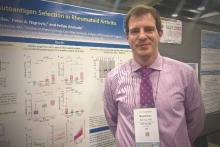SAN FRANCISCO – Autoantibodies in patients with rheumatoid arthritis target both the native and citrullinated forms of the RA33 autoantigen, challenging the idea that protein citrullination underlies loss of tolerance in this disease, Dr. Maximilian Konig said at the annual meeting of the American College of Rheumatology.
“I think the important thing is that this makes us rethink how RA actually starts,” Dr. Konig said in an interview. “We identified three different antibody groups that clinically behave very differently. We identified a group of patients that has cross-reactive antibodies against RA33, and they seem to be the ones with the highest and the most rapid disease progression. Maybe identifying these patients early and targeting them more would help bring a subset of patients with the most advanced and aggressive disease under better control.”
Signs and symptoms are often inconclusive early in the course of RA, leading to the search for reliable biomarkers that can hasten diagnosis and treatment. Anti-citrullinated protein antibodies (ACPAs) are one hallmark of RA, and protein citrullination has been seen as central to autoimmunity in its pathogenesis, said Dr. Konig, a postdoctoral fellow in rheumatology at Johns Hopkins University, Baltimore. But patients also have autoantibodies against native or unmodified proteins, including calpastatin, Fc-gamma, peptidylarginine deiminase type 4, and heterogeneous nuclear ribonucleoprotein A2/B1 (also known as RA33), which has been correlated with clinical disease activity, radiographic evidence of bone resorption, C-reactive protein levels, and erythrocyte sedimentation rate in a few previous studies (Pediatr Int. 2009 Apr;51[2]:188-92 and J Immunol Res. 2014;2014:516593).
Dr. Konig and his coinvestigators contended that current models of RA do not adequately account for autoimmunity against native proteins. To explore that idea, they tested sera from 196 patients from the ESCAPE RA (Evaluation of Subclinical Cardiovascular Disease and Predictors of Events in Rheumatoid Arthritis) cohort study and from 56 healthy controls. They used quantitative ELISA to identify autoantibodies, and performed immunoblotting and immunoprecipitation to test antibody specificity. They also used immunoblotting and mass spectrometry to study synovial fluid from the patients.
The assays identified citrullinated RA33 in the joints of RA patients, and revealed distinct autoantibodies that targeted native and citrullinated RA33. Furthermore, this single antibody system seemed to change with disease duration, Dr. Konig said. Autoantibody against native RA33 was almost exclusively found in samples from patients in early-stage disease, whereas patients with long-established RA had much higher levels of anti-citrullinated RA33 antibodies. The switch from a predominance of anti-RA33 to anti-citrullinated RA33 autoantibodies seemed to happen about a decade into the disease course, Dr. Konig added. “These data suggest that citrullination may not be required to break tolerance to RA33, and support a model in which RA autoantigens are initially targeted as a native protein, and only later become targets of a citrulline-specific response,” he said.
Notably, immunoprecipitation, immunoblotting, and competitive assays all confirmed a third type of autoantibody that cross-reacted against both RA33 and citrullinated RA33. The “RA33 [protein] is targeted by patient sera in three ways: only as a native protein, both as a native and as a citrullinated protein, and only as a citrullinated protein,” Dr. Konig concluded. He and his associates are exploring the clinical implications of the finding, particularly because patients with the cross-reactive anti-RA33 autoantibodies seem to have the most rapidly progressive and severe disease, he added. The presence of these antibodies might one day help identify a patient who needs especially aggressive monitoring and treatment, he concluded.
Dr. Konig had no disclosures.*
*This story was updated 12/3/2015.


